Papers by Maria Antonietta Salamone
Research Aspects in Arts and Social Studies Vol. 1
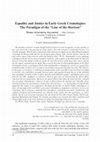
Filosofiâ i Kosmologiâ, 2017
The founders of Greek scientific thought believed justice in terms of equality. Cosmic equality, ... more The founders of Greek scientific thought believed justice in terms of equality. Cosmic equality, in fact, was conceived as the guaranty of cosmic justice: the order of nature is maintained because it is an order of equals. That the main components of the universe are equal was an old tradition in popular cosmology. In Hesiod earth and sky are declared equal (Theog. 126); and the distance between sky and earth is equal to that between earth and Tartarus (ibid. 719-25). Anaximander's own cosmology is designed with just such a sense of aesthetic symmetry, with equality as the main motif: the intervals between each of the infinite worlds are equal; the intervals between earth, fixed stars, moon, and sun are also equal; earth and sun are equal. This is exactly the sense in which equality figures in the whole development of early cosmological theory from Anaximander to Empedocles: powers are equal if they can hold another in check, in a way that no one of them is more powerful than an...
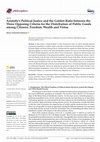
Philosophies
In this article, I interpret Book V of the Nicomachean Ethics in which Aristotle presents a geome... more In this article, I interpret Book V of the Nicomachean Ethics in which Aristotle presents a geometrical problem to explain which is the Best Criterion for the Distribution of Political and Economic Rights and Duties among Citizens, starting from the empirical evidence that there are three opposing opinions on which is the fairest distribution criterion: for some it is Freedom (Democrats), for others Wealth (Oligarchs), and for others Virtue (Aristocrats). Against the almost unique and most quoted interpretation of the geometrical problem, I present my mathematical solution, which I arrived at thanks to the Doctrine of the Four Causes and the Theory of the Mean. My thesis is that the Mean Term of Distributive Justice is the Golden Ratio between the opposite criteria of distribution, and the unjust distribution is the one that violates this ratio. This solution allows us to understand what is the Rational Principle at the basis of just distribution: that is, Geometrical Equality as op...
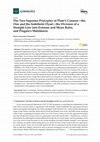
Symmetry
The objective of this paper is to propose a mathematical interpretation of the continuous geometr... more The objective of this paper is to propose a mathematical interpretation of the continuous geometric proportion (Timaeus, 32a) with which Plato accomplishes the goal to unify, harmonically and symmetrically, the Two Opposite Elements of Timaeus Cosmos—Fire and Earth—through the Mean Ratio. As we know, from the algebraic point of view, it is possible to compose a continuous geometric proportion just starting from two different quantities a (Fire) and b (Earth); their sum would be the third term, so that we would obtain the continuous geometric proportion par excellence, which carries out the agreement of opposites most perfectly: (a + b)/a = a/b. This equal proportion, applied to linear geometry, corresponds to what Euclid called the Division into Extreme and Mean Ratio (DEMR) or The Golden Proportion. In fact, according to my mathematical interpretation, in the Timaeus 32b and in the Epinomis 991 a–b, Plato uses Pingala’s Mātrāmeru or The First Analogy of the Double to mould the body...
Logos. Anales del Seminario de Metafísica, 2013
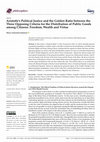
Philosophies , Nov 27, 2021
In this article, I interpret Book V of the Nicomachean Ethics in which Aristotle presents
a geom... more In this article, I interpret Book V of the Nicomachean Ethics in which Aristotle presents
a geometrical problem to explain which is the Best Criterion for the Distribution of Political and Economic Rights and Duties among Citizens, starting from the empirical evidence that there are three opposing opinions on which is the fairest distribution criterion: for some it is Freedom (Democrats), for others Wealth (Oligarchs), and for others Virtue (Aristocrats). Against the almost unique and most quoted interpretation of the geometrical problem, I present my mathematical solution, which I arrived at thanks to the Doctrine of the Four Causes and the Theory of the Mean. My thesis is that the Mean Term of Distributive Justice is the Golden Ratio between the opposite criteria of distribution, and the unjust distribution is the one that violates this ratio. This solution allows us to understand what is the Rational Principle at the basis of just distribution: that is, Geometrical Equality as opposed to Arithmetical Equality. Indeed, by applying the geometric figure of the Golden Triangle to the different political constitutions, I show, in line with Politics, that the Best Form of Government is the Aristocratic Politeia, i.e., a mixture of Democracy, Oligarchy and Aristocracy
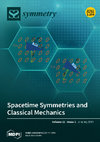
Symmetry, 11(1) 98, Jan 16, 2019
The objective of this paper is to propose a mathematical interpretation of the continuous geometr... more The objective of this paper is to propose a mathematical interpretation of the continuous geometric proportion (Timaeus, 32a) with which Plato accomplishes the goal to unify, harmonically and symmetrically, the Two Opposite Elements of Timaeus Cosmos—Fire and Earth—through the Mean Ratio. As we know, from the algebraic point of view, it is possible to compose a continuous geometric proportion just starting from two different quantities a (Fire) and b (Earth); their sum would be the third term, so that we would obtain the continuous geometric proportion par excellence, which carries out the agreement of opposites most perfectly: (a + b)/a = a/b. This equal proportion, applied to linear geometry, corresponds to what Euclid called the Division into Extreme and Mean Ratio (DEMR) or The Golden Proportion. In fact, according to my mathematical interpretation, in the Timaeus 32b and in the Epinomis 991 a–b, Plato uses Pingala’s Mātrāmeru or The First Analogy of the Double to mould the body of the Cosmos as a whole, to the point of identifying the two supreme principles of the Cosmos—the One (1) and the Indefinite Dyad (Φ and1/Φ)—with the DEMR. In effect, Fire and Earth are joined not by a single Mean Ratio but by two (namely, Air and Water). Moreover, using the Platonic approach to analyse the geometric properties of the shape of the Cosmos as a whole, I think that Timaeus constructed the 12 pentagonal faces of Dodecahedron by means of elementary Golden Triangles (a/b = Φ) and the Mātrāmeru sequence. And, this would prove that my mathematical interpretation of the platonic texts is at least plausible.
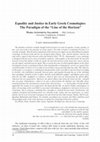
Philosophy and Cosmology , Feb 2017
The founders of Greek scientic thought believed justice in terms of equality. Cosmic equality, i... more The founders of Greek scientic thought believed justice in terms of equality. Cosmic equality, in fact, was conceived as the guaranty of cosmic justice: the order of nature is maintained because it is an order of equals. That the main components of the universe are equal was an old tradition in popular cosmology. In Hesiod earth and sky are declared equal (Theog. 126); and the distance between sky and earth is equal to that between earth and Tartarus (ibid. 719-25). Anaximander’s own cosmology is designed with just such a sense of aesthetic symmetry, with equality as the main motif: the intervals between each of the innite worlds are equal; the intervals between earth, xed stars, moon, and sun are also equal; earth and sun are equal. This is exactly the sense in which equality gures in the whole development of early cosmological theory from Anaximander to Empedocles: powers are equal if they can hold another in check, in a way that no one of them is more powerful than any other. The objective of this paper is to propose a cosmological interpretation of the term díkē in ancient Greek according to Aristotle, who establishes synonymy between justice and equality through the use of the «dividing line» paradigm. Aristotle reveals, in eect, that the words diksastḗs «judge» and dikaion «just» come from the root díkē, «judgment or sentence», which in their turn are derived from the adverb dīksā, «division into two equal parts». Moreover, the adverb dīksā comes from the Greek root dís-, «divided into two parts, dichotomous», which in its turn is derived from the Sanskrit root *diś-(dik) whose meaning indicates the astronomical concept of the «horizon line», — i.e. the boundary line that divides apparently the cosmos in two equal parts, the Earth and the Sky. As said by Palmer and Gagarin, in eect, the meaning of the word Díkē is associated with making a «judgment or decision» between two contestants, that is, placing a «dividing line» (straight or crooked) between them. Furthermore, this original conception representing justice as a division of the cosmos into two equal parts, or cosmic dasmós, has its roots in ancient cosmogony not only Greek but also Indo-Iranian, Hindus, Old Persian, Egyptian, Babylonian and Chinese. To conclude, according to my research, also Plato could have used the paradigm of the «Line of the horizon» to explain his cosmological Doctrine of Idea.

Argumentos de Razón Técnica, Número 21, 2018
Resumen: El nuevo paradigma de la Computación en la Nube se identifica actualmente con la teoría ... more Resumen: El nuevo paradigma de la Computación en la Nube se identifica actualmente con la teoría política anarco-capitalista. Su objetivo es la explotación del territorio virtual a través del digital profiling para influir en las preferencias políticas de los ciudadanos-consumidores. El objetivo de la Democracia Liquida es la supresión de las viejas tecno-burocracias estatales mediante la promoción de nuevas tecno-burocracias digitales, cuyos mecanismos de funcionamientos son más oscuros que los precedentes. En nombre de la nueva libertad negativa automática y gratuita, la Ciudadanía 2.0 ha otorgado un mandato de gobierno privado a los dueños de la Computación en Nube para la defensa de sus derechos privados, en lugar de reivindicar un mayor espacio público para ejercer su razón práctica y defender la libertad republicana. Abstract: The new paradigm of Cloud Computing currently identifies itself as anarcho-capitalist political theory. Its objective is to exploit the virtual territory through digital profiling in order to influence citizen-consumers' political preferences. The purpose of the so-called liquid democracy is the suppression of old state techno-bureaucracies, and the promotion of new digital techno-bureaucracies, whose operating mechanisms are even darker than the previous ones. In the name of a brand new free of charge, automatic, and negative freedom. Instead of claiming a larger public space for exercising its practical reason and defend republican freedom, Citizenship 2.0 has granted a mandate of private government to the owners of Cloud Computing to protect their private rights.
Argumentos de Razón Técnica, 2018
El nuevo paradigma de la Computación en la Nube se identifica actualmente con la teoría política ... more El nuevo paradigma de la Computación en la Nube se identifica actualmente con la teoría política anarco-capitalista. Su objetivo es la explotación del territorio virtual a través del digital profiling para influir en las preferencias políticas de los ciudadanos-consumidores. El objetivo de la Democracia Liquida es la supresión de las viejas tecno-burocracias estatales mediante la promoción de nuevas tecno-burocracias digitales, cuyos mecanismos de funcionamientos son más oscuros que los precedentes. En nombre de la nueva libertad negativa automática y gratuita, la Ciudadanía 2.0 ha otorgado un mandato de gobierno privado a los dueños de la Computación en Nube para la defensa de sus derechos privados, en lugar de reivindicar un mayor espacio público para ejercer su razón práctica y defender la libertad republicana.
PHILOSOPHY AND COSMOLOGY 2017 (VOL.18), Feb 2017
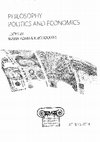
Philosophy, politics and economics, 2014
The objective of this paper is to offer a mathematical and philosophical solution to the geometri... more The objective of this paper is to offer a mathematical and philosophical solution to the geometrical theorem that was put forward by Aristotle in the Fifth Book of the Nicomachean Ethics in relation with the search for the medium term of Distributive Justice. According to this interpretation, in fact, the just distribution of economical and political rights and duties among citizens must be a mean proportional (golden section) between the three distributive criteria: virtue (aristocracy), liberty (democracy), and wealth (oligarchy). As a matter of fact, in the application of the solution of the theorem (in the paradigm of the golden triangle) in Politics, it becomes scientifically apparent that for Aristotle the best political constitution is the Aristocratic Republic. Finally, in this paper not only is the metaphysical foundation of Aristotelian Ethics and Politics underlined (doctrine of the four causes and doctrine of the medium term) but also the mediating function of mathematical sciences in Aristotelian epistemology and ontology.
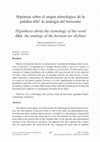
Logos. Anales del Seminario de Metafísica. Vol.46 (2013), Dec 5, 2013
"Resumen:
Objeto del presente artículo es demostrar la vinculación filológica entre la justicia,... more "Resumen:
Objeto del presente artículo es demostrar la vinculación filológica entre la justicia, el derecho y la igualdad en el antiguo idioma griego o, que es lo mismo, la vinculación filosófica entre la ética, la política y la economía. Es interesante, pues, examinar el origen etimológico de la palabra díkē que procede de la raíz sánscrita
diś-(dik) y hace referencia más que al concepto genérico de «línea recta», al concepto especifico y astronómico de «línea del horizonte» que divide aparentemente el cosmos en dos partes iguales, la tierra y el cielo, significando la misma idea de igualdad la cual debe servir de regla para la norma justa y la perfección ética. Según mi análisis, además, el mismo Platón pudo haber utilizado la analogía de la línea del horizonte para explicar su cosmológica Doctrina de las Ideas.
Palabras clave: etimología, díkē, justicia, línea del horizonte, igualdad, Platón, cosmología, metafísica.
Abstract:
The object of this paper is to demonstrate the philological relation between justice, law and equality in ancient Greek or, that is the same, the philosophical relation between ethics, politics and economics. Actually it is interesting to examine the etymology of the word díkē which derives from the Sanskrit diś-(dik) and it refers more than to the generic idea of the «straight line» to the specific and astronomical concept of the «horizon (or skyline)», the apparent line that separates the cosmos into two equal parts, the earth from the sky, meaning the same idea of equality which should be a rule of just law and ethical perfection. Moreover, according to my hypothesis Plato may have used the analogy of the horizon to explain his cosmological Doctrine of Ideas.
Keywords: etymology, Díkē, Justice, Horizon (Skyline), equality, Plato,Cosmology, Metaphysic.""
… Moderno y Metodología en Historia de la …, 2011
RESUMEN A la doctrina del "absolutismo regio" formulada por N. Maquiavelo en El Príncipe, y luego... more RESUMEN A la doctrina del "absolutismo regio" formulada por N. Maquiavelo en El Príncipe, y luego apoyada por las Reforma Protestante, se contrapuso en el siglo XVI (1513) la doctrina republicana del "contrato social" celebrada por Mario Salamone en El Principado. Esta doctrina fue luego respaldada por los jesuitas españoles, como F. Suárez, y los calvinistas franceses o alemanes, como J. Althusius, que defenderán el principio de la Soberanía popular, es decir el origen ético-jurídico del poder político, o el estado de derecho, frente a la Teocracia
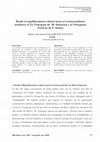
Ingenium. Revista de historia del pensamiento moderno Nº5, enero-junio, 2011, , Oct 13, 2011
RESUMEN:
La doctrina del “absolutismo regio” formulada por N. Maquiavelo en El Príncipe, y lu... more RESUMEN:
La doctrina del “absolutismo regio” formulada por N. Maquiavelo en El Príncipe, y luego apoyada por las Reforma Protestante, se contrapuso en el siglo XVI (1513) la doctrina republicana del “contrato social” celebrada por Mario Salamone en El Principado. Esta doctrina fue luego respaldada por los jesuitas españoles, como F. Suárez, y los calvinistas franceses o alemanes, como J. Althusius, que defenderán el principio de la Soberanía popular, es decir el origen ético-jurídico del poder político, o el estado de derecho, frente a la Teocracia
PALABRAS CLAVES: republicanismo; contractualismo; Mario Salamone; Francisco Suárez.
ABSTRACT:
In the sixteenth century (1513), the doctrine of “royal absolutism”, proposed by N. Machiavelli in The Prince and then supported by the Protestant Reformation, was contrasted by the Republican doctrine of “social contract”, formulated by M. Salamone in The Principality. This doctrine was further supported by the Spanish Jesuits as F. Suárez, and the French or German Calvinists as J. Althusius, whose will defend the principle of popular sovereignty, that is to say the ethical-legal foundation of political power, or the rule of law, against Theocracy.
KEY WORDS: republicanism; contractualism; Mario Salamone; Francisco Suárez."
El Rapto De Europa Critica De La Cultura, 2003
Talks by Maria Antonietta Salamone

The objective of this paper is to offer a mathematical and philosophical solution to the geometri... more The objective of this paper is to offer a mathematical and philosophical solution to the geometrical theorem that was put forward by Aristotle in the Fifth Book of the Nicomachean Ethics in relation with the search for the medium term of Distributive Justice. According to this interpretation, in fact, the just distribution of economical and political rights and duties among citizens must be a mean proportional (golden section) between the three distributive criteria: virtue (aristocracy), liberty (democracy), and wealth (oligarchy). As a matter of fact, in the application of the solution of the theorem (in the paradigm of the golden triangle) in Politics, it becomes scientifically apparent that for Aristotle the best political constitution is the Aristocratic Republic. Finally, in this paper not only is the metaphysical foundation of Aristotelian Ethics and Politics underlined (doctrine of the four causes and doctrine of the medium term) but also the mediating function of mathematical sciences in Aristotelian epistemology and ontology.
Books by Maria Antonietta Salamone
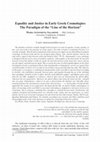
The founders of Greek scientific thought believed justice in terms of equality. Cosmic equality, ... more The founders of Greek scientific thought believed justice in terms of equality. Cosmic equality, in fact, was conceived as the guaranty of cosmic justice: the order of nature is maintained because it is an order of equals. That the main components of the universe are equal was an old tradition in popular cosmology. In Hesiod earth and sky are declared equal (Theog. 126); and the distance between sky and earth is equal to that between earth and Tartarus (ibid. 719-25). Anaximander’s own cosmology is designed with just such a sense of aesthetic symmetry, with equality as the main motif: the intervals between each of the infinite worlds are equal; the intervals between earth, fixed stars, moon, and sun are also equal; earth and sun are equal. This is exactly the sense in which equality figures in the whole development of early cosmological theory from Anaximander to Empedocles: powers are equal if they can hold another in check, in a way that no one of them is more powerful than any ot...

Current Topics on Mathematics and Computer Science Vol. 1, 2021
The objective of this paper is to propose a mathematical interpretation of the continuous geometr... more The objective of this paper is to propose a mathematical interpretation of the continuous geometric proportion (Timaeus, 32a) with which Plato accomplishes the goal to unify, harmonically and symmetrically, the Two Opposite Elements of Timaeus Cosmos—Fire and Earth—through the Mean Ratio. As we know, from the algebraic point of view, it is possible to compose a continuous geometric proportion just starting from two different quantities a (Fire) and b (Earth); their sum would be the third term, so that we would obtain the continuous geometric proportion par excellence, which carries out the agreement of opposites most perfectly: (a + b)/a = a/b. This equal proportion, applied to linear geometry, corresponds to what Euclid called the Division into Extreme and Mean Ratio (DEMR) or The Golden Proportion. In fact, according to my mathematical interpretation, in the Timaeus 32b and in the Epinomis 991 a–b, Plato uses Pingala’s Matrameru or The First Analogy of the Double to mould the body...

La investigacion se propone demostrar la conexion historico-juridico-cultural entre el Corpus Iur... more La investigacion se propone demostrar la conexion historico-juridico-cultural entre el Corpus Iuris Civilis romano, la Constitucion florentina de 1494, la Gloriosa Revolucion, el Bill of Rights, la Revolucion americana ademas de la misma Constitucion de los Estados Unidos. O lo que es lo mismo, recorrer la ruta politica mediterraneo-atlantica propia de la tradicion republicana, dejandonos acompanar por uno de sus mas destacados protagonistas: Mario Salamone de Alberteschi. Durante el Renacimiento italiano, la concepcion politica de la Virtud Republicana inaugurada por el gran humanista juridico M. Salamone de Alberteschi que teoriza por primera vez la idea del contrato social como fundamento de la sociedad politica y del Estado de derecho, se contrapone cada vez mas al Realismo Politico del contemporaneo N. Maquiavelo que, separando la etica de la politica, inaugura la tesis del absolutismo y de la Razon de estado. Las obras fundamentales de estos dos autores - El Principado y El Pr...


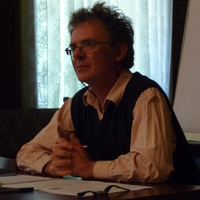








Uploads
Papers by Maria Antonietta Salamone
a geometrical problem to explain which is the Best Criterion for the Distribution of Political and Economic Rights and Duties among Citizens, starting from the empirical evidence that there are three opposing opinions on which is the fairest distribution criterion: for some it is Freedom (Democrats), for others Wealth (Oligarchs), and for others Virtue (Aristocrats). Against the almost unique and most quoted interpretation of the geometrical problem, I present my mathematical solution, which I arrived at thanks to the Doctrine of the Four Causes and the Theory of the Mean. My thesis is that the Mean Term of Distributive Justice is the Golden Ratio between the opposite criteria of distribution, and the unjust distribution is the one that violates this ratio. This solution allows us to understand what is the Rational Principle at the basis of just distribution: that is, Geometrical Equality as opposed to Arithmetical Equality. Indeed, by applying the geometric figure of the Golden Triangle to the different political constitutions, I show, in line with Politics, that the Best Form of Government is the Aristocratic Politeia, i.e., a mixture of Democracy, Oligarchy and Aristocracy
Objeto del presente artículo es demostrar la vinculación filológica entre la justicia, el derecho y la igualdad en el antiguo idioma griego o, que es lo mismo, la vinculación filosófica entre la ética, la política y la economía. Es interesante, pues, examinar el origen etimológico de la palabra díkē que procede de la raíz sánscrita
diś-(dik) y hace referencia más que al concepto genérico de «línea recta», al concepto especifico y astronómico de «línea del horizonte» que divide aparentemente el cosmos en dos partes iguales, la tierra y el cielo, significando la misma idea de igualdad la cual debe servir de regla para la norma justa y la perfección ética. Según mi análisis, además, el mismo Platón pudo haber utilizado la analogía de la línea del horizonte para explicar su cosmológica Doctrina de las Ideas.
Palabras clave: etimología, díkē, justicia, línea del horizonte, igualdad, Platón, cosmología, metafísica.
Abstract:
The object of this paper is to demonstrate the philological relation between justice, law and equality in ancient Greek or, that is the same, the philosophical relation between ethics, politics and economics. Actually it is interesting to examine the etymology of the word díkē which derives from the Sanskrit diś-(dik) and it refers more than to the generic idea of the «straight line» to the specific and astronomical concept of the «horizon (or skyline)», the apparent line that separates the cosmos into two equal parts, the earth from the sky, meaning the same idea of equality which should be a rule of just law and ethical perfection. Moreover, according to my hypothesis Plato may have used the analogy of the horizon to explain his cosmological Doctrine of Ideas.
Keywords: etymology, Díkē, Justice, Horizon (Skyline), equality, Plato,Cosmology, Metaphysic.""
La doctrina del “absolutismo regio” formulada por N. Maquiavelo en El Príncipe, y luego apoyada por las Reforma Protestante, se contrapuso en el siglo XVI (1513) la doctrina republicana del “contrato social” celebrada por Mario Salamone en El Principado. Esta doctrina fue luego respaldada por los jesuitas españoles, como F. Suárez, y los calvinistas franceses o alemanes, como J. Althusius, que defenderán el principio de la Soberanía popular, es decir el origen ético-jurídico del poder político, o el estado de derecho, frente a la Teocracia
PALABRAS CLAVES: republicanismo; contractualismo; Mario Salamone; Francisco Suárez.
ABSTRACT:
In the sixteenth century (1513), the doctrine of “royal absolutism”, proposed by N. Machiavelli in The Prince and then supported by the Protestant Reformation, was contrasted by the Republican doctrine of “social contract”, formulated by M. Salamone in The Principality. This doctrine was further supported by the Spanish Jesuits as F. Suárez, and the French or German Calvinists as J. Althusius, whose will defend the principle of popular sovereignty, that is to say the ethical-legal foundation of political power, or the rule of law, against Theocracy.
KEY WORDS: republicanism; contractualism; Mario Salamone; Francisco Suárez."
Talks by Maria Antonietta Salamone
Books by Maria Antonietta Salamone
a geometrical problem to explain which is the Best Criterion for the Distribution of Political and Economic Rights and Duties among Citizens, starting from the empirical evidence that there are three opposing opinions on which is the fairest distribution criterion: for some it is Freedom (Democrats), for others Wealth (Oligarchs), and for others Virtue (Aristocrats). Against the almost unique and most quoted interpretation of the geometrical problem, I present my mathematical solution, which I arrived at thanks to the Doctrine of the Four Causes and the Theory of the Mean. My thesis is that the Mean Term of Distributive Justice is the Golden Ratio between the opposite criteria of distribution, and the unjust distribution is the one that violates this ratio. This solution allows us to understand what is the Rational Principle at the basis of just distribution: that is, Geometrical Equality as opposed to Arithmetical Equality. Indeed, by applying the geometric figure of the Golden Triangle to the different political constitutions, I show, in line with Politics, that the Best Form of Government is the Aristocratic Politeia, i.e., a mixture of Democracy, Oligarchy and Aristocracy
Objeto del presente artículo es demostrar la vinculación filológica entre la justicia, el derecho y la igualdad en el antiguo idioma griego o, que es lo mismo, la vinculación filosófica entre la ética, la política y la economía. Es interesante, pues, examinar el origen etimológico de la palabra díkē que procede de la raíz sánscrita
diś-(dik) y hace referencia más que al concepto genérico de «línea recta», al concepto especifico y astronómico de «línea del horizonte» que divide aparentemente el cosmos en dos partes iguales, la tierra y el cielo, significando la misma idea de igualdad la cual debe servir de regla para la norma justa y la perfección ética. Según mi análisis, además, el mismo Platón pudo haber utilizado la analogía de la línea del horizonte para explicar su cosmológica Doctrina de las Ideas.
Palabras clave: etimología, díkē, justicia, línea del horizonte, igualdad, Platón, cosmología, metafísica.
Abstract:
The object of this paper is to demonstrate the philological relation between justice, law and equality in ancient Greek or, that is the same, the philosophical relation between ethics, politics and economics. Actually it is interesting to examine the etymology of the word díkē which derives from the Sanskrit diś-(dik) and it refers more than to the generic idea of the «straight line» to the specific and astronomical concept of the «horizon (or skyline)», the apparent line that separates the cosmos into two equal parts, the earth from the sky, meaning the same idea of equality which should be a rule of just law and ethical perfection. Moreover, according to my hypothesis Plato may have used the analogy of the horizon to explain his cosmological Doctrine of Ideas.
Keywords: etymology, Díkē, Justice, Horizon (Skyline), equality, Plato,Cosmology, Metaphysic.""
La doctrina del “absolutismo regio” formulada por N. Maquiavelo en El Príncipe, y luego apoyada por las Reforma Protestante, se contrapuso en el siglo XVI (1513) la doctrina republicana del “contrato social” celebrada por Mario Salamone en El Principado. Esta doctrina fue luego respaldada por los jesuitas españoles, como F. Suárez, y los calvinistas franceses o alemanes, como J. Althusius, que defenderán el principio de la Soberanía popular, es decir el origen ético-jurídico del poder político, o el estado de derecho, frente a la Teocracia
PALABRAS CLAVES: republicanismo; contractualismo; Mario Salamone; Francisco Suárez.
ABSTRACT:
In the sixteenth century (1513), the doctrine of “royal absolutism”, proposed by N. Machiavelli in The Prince and then supported by the Protestant Reformation, was contrasted by the Republican doctrine of “social contract”, formulated by M. Salamone in The Principality. This doctrine was further supported by the Spanish Jesuits as F. Suárez, and the French or German Calvinists as J. Althusius, whose will defend the principle of popular sovereignty, that is to say the ethical-legal foundation of political power, or the rule of law, against Theocracy.
KEY WORDS: republicanism; contractualism; Mario Salamone; Francisco Suárez."
La finalità è quella di stimolare un dibattito istituzionale a livello regionale e locale per la definizione di obiettivi politici sulle pari opportunità in questi specifici settori. L'impianto generale della ricerca parte, infatti, dal presupposto che nella nostra società l'esclusione delle donne per ragioni di sesso, educazione e aspettative sociali di genere stereotipate, ha un profondo radicamento storico e culturale.
Bibliografia: María Antonietta Salamone, "La idea del contrato social en Mario Salamone de Alberteschi. Sus vínculos con la Escuela de Salamanca y el Constitucionalismo inglés".
Istituto della Enciclopedia Italiana, 2014, pp. 473-474.